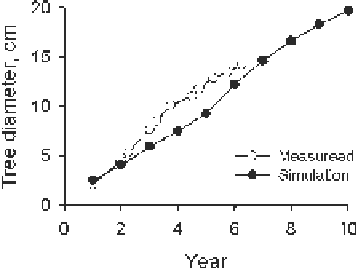Agriculture Reference
In-Depth Information
6.2.2
Model Scenario for the Philippines
Two timber
(Eucalyptus deglupta
or mindanao gum and
Gmelina arborea
or white
teak, yemane) and non-timber (
Lansium domesticum
or langsat, lansones and
Mangifera indica
or mango) trees were selected for the modeling activity of the
shade-based control for
Imperata
grasslands (Table 6.2). The tree-based hedgerow
systems were grown in
Imperata
grassland area with an annual rainfall of 1,775 mm
(total rainfall recorded in the project area from January to December 2004) and a
slope of 18 percent. The soil of the study area is Jasaan clay with 1.98 percent to
2.21 percent organic matter (OM) and a bulk density of 0.93 to 1.05 g cm
−3
. To
determine the relationship between the relative light captured by
Imperata
and the
tree canopy width, non-linear regression was done for the simulated data. Based on
the above scenarios, the following parameters were analyzed:
1. Tree growth performance (diameter) when grown in an
Imperata
grassland
2. Relative light captured/received by
Imperata
as a function of canopy width of
timber and non-timber trees
3. Shading effect of timber and non-timber trees on control of
Imperata
growth
Fig. 6.2
Simulation (with Zone 1 kept free of weeds) and measurement (with strip weeding) of
rubber tree diameter in experiments in West Kalimantan (Mulyoutami et al. 2005)
Table 6.2
Systems modeled for the shade-based
Imperata
control
Tree species
Spacing (m × m)
Tree density (ha
−1
)
Eucalyptus deglupta
1 × 3
3,000
1 × 9
1,000
Gmelina arborea
1 × 3
3,000
1 × 9
1,000
Lansium domesticum
5 × 5
400
10 × 10
100
Mangifera indica
5 × 5
400
10 × 10
100



Search WWH ::

Custom Search